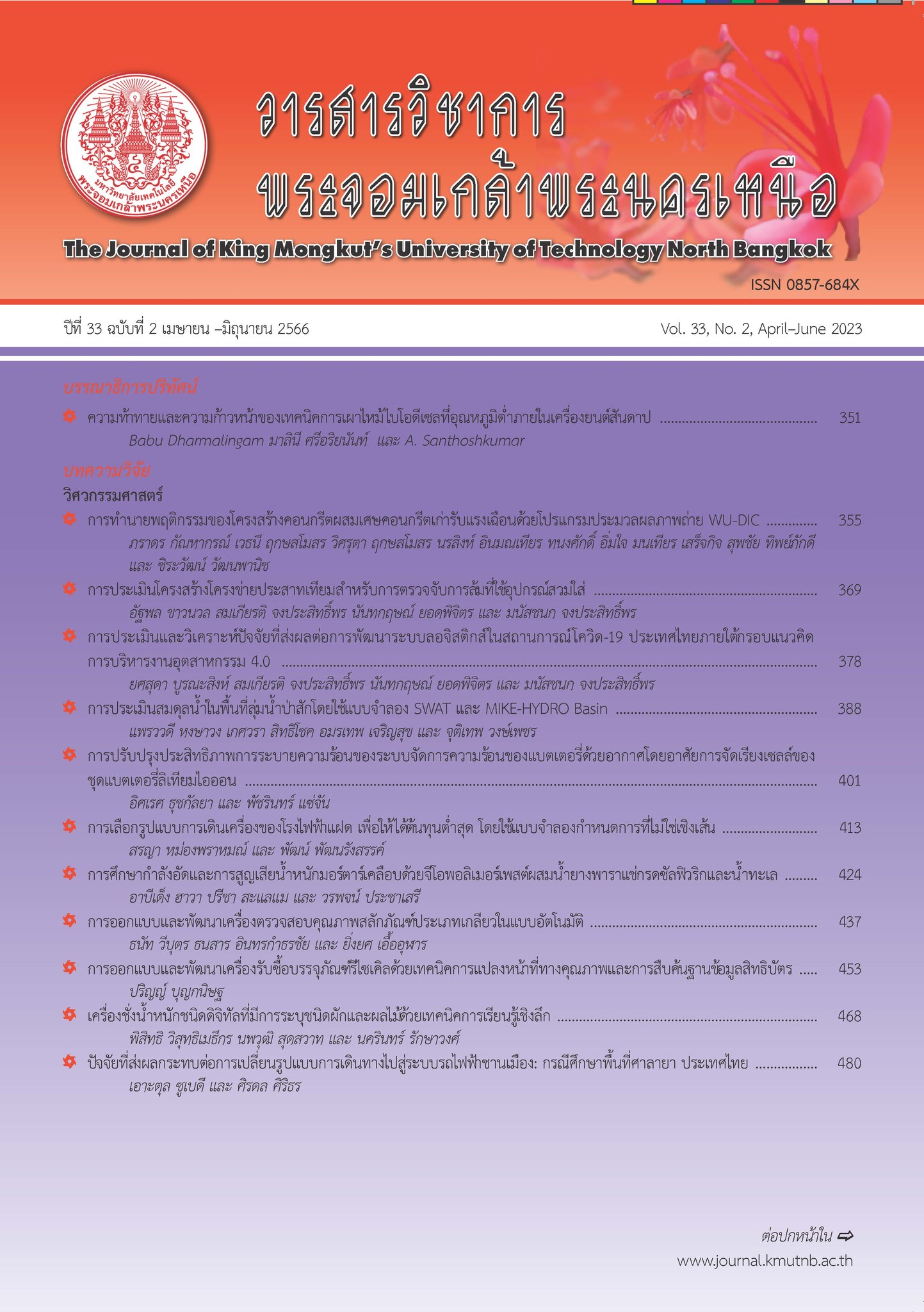กลยุทธ์การปรับตัวของอุตสาหกรรมการผลิตชิ้นส่วนยานยนต์เพื่อรองรับนโยบายไทยแลนด์ 4.0
Main Article Content
บทคัดย่อ
การปรับตัวให้สอดคล้องกับนโยบายไทยแลนด์ 4.0 สร้างความได้เปรียบในการแข่งขันต่ออุตสาหกรรมการผลิตชิ้นส่วนยานยนต์ การวิจัยนี้มีวัตถุประสงค์เพื่อศึกษากลยุทธ์การปรับตัวของอุตสาหกรรมการผลิตชิ้นส่วนยานยนต์เพื่อรองรับนโยบายไทยแลนด์ 4.0 ดำเนินการวิจัยทั้งเชิงคุณภาพและเชิงปริมาณ สำรวจข้อมูลเชิงปริมาณด้วยแบบสอบถามจากผู้ประกอบการ และผู้บริหาร จำนวน 500 ราย ผลการวิจัยพบว่า กลยุทธ์การปรับตัวของอุตสาหกรรมการผลิตชิ้นส่วนยานยนต์เพื่อรองรับนโยบายไทยแลนด์ 4.0 ด้านการพัฒนาการบริการภิวัฒน์ ( = 4.10) ได้แก่ จัดโปรแกรมให้ลูกค้าเข้าศึกษาดูเทคโนโลยีและวัสดุการผลิตชิ้นส่วนยานยนต์สมัยใหม่ ด้านการพัฒนาองค์กร ( = 4.26) ได้แก่ สถานที่ทำงานเอื้อประโยชน์ต่อการผลิตที่มีประสิทธิภาพ ด้านการพัฒนาเทคโนโลยีและนวัตกรรม ( = 4.16) ได้แก่ จัดการลดความสูญเสียในขบวนการผลิตปัจจุบันด้วยระบบลีนก่อนนำระบบอัตโนมัติมาใช้ และด้านการพัฒนาทักษะแรงงาน ( = 4.27) ได้แก่ พัฒนาแรงงานให้สามารถควบคุมอารมณ์ภายใต้แรงกดดัน ผลการทดสอบสมมติฐานพบว่า กลยุทธ์การปรับตัวของอุตสาหกรรมการผลตชิ้นส่วนยานยนต์เพื่อรองรับนโยบายไทยแลนด์ 4.0 เมื่อจำแนกตามขนาดองค์กรธุรกิจแล้วไม่แตกต่างกันอย่างมีนัยสําคัญทางสถิติที่ระดับ 0.05 ผลการวิเคราะห์ตัวแบบจําลองสมการโครงสร้างที่ได้พัฒนาขึ้น พบว่า ผ่านตามเกณฑ์การประเมิน มีความสอดคล้องกับข้อมูลเชิงประจักษ์ โดยมีค่าระดับความน่าจะเป็นของไคสแควร์เท่ากับ 0.261 ค่าไคสแควร์สัมพัทธ์ เท่ากับ 1.048 ค่าดัชนีวัดระดับความสอดคล้อง เท่ากับ 0.953 และค่าดัชนีรากของค่าเฉลี่ยกําลังสองของการประมาณค่าความคลาดเคลื่อน เท่ากับ 0.010
Article Details

อนุญาตภายใต้เงื่อนไข Creative Commons Attribution-NonCommercial-NoDerivatives 4.0 International License.
บทความที่ลงตีพิมพ์เป็นข้อคิดเห็นของผู้เขียนเท่านั้น
ผู้เขียนจะต้องเป็นผู้รับผิดชอบต่อผลทางกฎหมายใดๆ ที่อาจเกิดขึ้นจากบทความนั้น
เอกสารอ้างอิง
Bank f Thaiand. (2018, March). Import and Export Statistics. [Online]. Available: https:// www.bot.or.th/Thai/Statistics/Graph /Pages/ FDI.aspx
World Economic Forum. (2019). The 2019 Edition of the Global Competitiveness Report Series. World Economic Forum. [Online]. Available: http://reports.weforum.org/globalcompetitiveness- report
P. Rudchatawctchakun, N. Attharangsun, and K. Vongka, “Effects of excellence management on organization success of thai automotive industry,” Journal of Accountancy and Management, vol. 12, no. 4, pp. 109–120, 2020.
The Federation of Thailand. (2020, January). Automotive Industry Club. [Online]. Available: http:// www.aic.or.th/ data-statistics
S. Tiengtavaj, T. Phimonsathien, and W. Fongsuwan, “Ensuring competitive advantage through innovation capability and clustering in the thai automotive parts molding industry: A SEM approach,” Management and Production Engineering Review, vol. 8, no. 1, pp. 89–100, 2017.
A. Alavi, M. Shokri, B. Zhiani, and S. Zhiani, “Analysing competitive advantage of Iranian automotive industry using Porter's diamond model, case study: Iranian car manufacturers,” International Journal of Business and Systems Research, vol. 14, no. 3, pp. 298–313, 2019.
A. Kvedariene, “Strategic technology management within global value systems” Journal of Open Economics, vol. 2, no. 1, pp. 43–52, 2019.
N. Bennett and G. N. Lemoine, “What VUCA really means for you,” Harvard Business Review, vol. 92, no. 1-2, 2014.
K. Vey, T. Fandel-Meyer, and J. ZippK, “Learning & development in times of digital transformation: Facilitating a culture of change and innovation,” International Journal of Advanced Corporate Learning, vol. 10, no. 1, 2017.
S. Buer, J. Strandhagen, and S. Chan, “The link between industry 4.0 and lean manufacturing: Mapping current research and establishing a research agenda,” International Journal of Production Research, vol 56, no. 8, pp. 2924– 2940, 2018.
I. Karabegovic, “The role of industrial robots in the development of automotive industry in China,” International Journal of Engineering Works, vol. 3, no. 12, pp. 92–97, 2016.
C. Pensute, “Thailand 4.0 economics and political contexts,” Political Science and Public Administration Journal, vol. 8, no. 1, pp. 67–99, 2017.
N. Phumma, (2017, March). Thailand 4.0. Available: http://www.setthasarn.econ.tu.ac. th/blog/detail/16/
F. V-Herrero, G. Parry, O. F. Bustinza, and N. O'Regan, “Servitization as a driver for organizational change,” Strategic Change, vol. 23, no. 5–6, pp. 279–285, 2014.
W. Noongam and T. Silpcharu, “Management strategies for achieving sustainable excellence in the industrial business sector,” The Journal of KMUTNB, vol. 31, no. 1, pp. 144–157, 2021.
M. Santoso and S. Bukit, “The determinant factors of automotive industry investment decision in Indonesia,” Junior Scientific Researcher, vol. 5, no. 1, pp. 3–17, 2019.
A. Petrillo, F. Felice, and A. Zomparelli, “Performance measurement for worldclass manufacturing: A model for the Italian automotive industry,” Journal Total Quality Management & Business Excellence, vol. 30, no. 2, pp. 1–28, 2018.
K. Schwab, The Fourth Industrial Revolution, Geneva: World Economic Forum, 2016.
O. Aranyapruk and S. Worawattanaparinya, “The guidelines for developing the desirable competencies of operational labors in the petrochemical industry,” Academy of Strategic Management Journal, vol. 19, no. 2, pp. 1–11, 2020.
S. Wantanakomol and T. Silpcharu, “Strategy for preventing corruptions in industrial business organization with delphi technique,” Academy of Strategic Management Journal, vol. 19, no. 3, 2020.
J. Sirihong. (2019, January). People Development in Manufacturing Industry. [Online]. Available: http://wiki.ocsc.go.th/_media
A. N. Azmi, Y. Kamin, and M. K. Noordin, “Towards industrial revolution 4.0: Employers' expectations on fresh engineering graduates,” International Journal of Engineering & Technology, vol. 7, no. 8, pp. 267–272, 2018.
T. Roopsing and T. Artsri, “Factors affecting the management success of small and medium enterprises in the electrical and electronic industry in Thailand,” Academy of Strategic Management Journal, vol. 18, no. 2, pp. 1–17, 2019.

